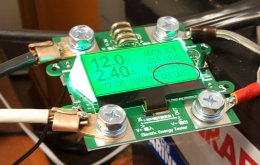Inq720
Odysseus, expert on the Siren's call
Preamble
I am going to be doing some wiring in a sailboat. From large gauge for the Inverter and Windlass down to tiny stuff needed for LED lighting. The boating industry has somehow gotten into its head that all wiring must be tinned, which seems strange, since apparently soldering a lug on a wire is no-no also. Apparently decades ago, some vendor did an article and everyone jumped on board till now its expected. Fantastic marketing! Turns out almost no boat manufacturers uses tinned wire and no standard actually specifies tinned wire. Anyhow it's expensive. I don't want to use it.
Question
Now I know from repairing and replacing trailer wire that it corrodes in wet environments. The trick is to seal all the stranded wire from the moisture. Heat shrink helps, but doesn't eliminate all paths. What I want to know... if I crimp the lugs on the wires, tape over the screw area of the lug and dunk them in plastic will this cause any problems?
I'd use scrap ABS plastic that I have from my 3D Printing and melt it down with Acetone. I can make it as thin or thick as I want it. Considering it would flow around the strands inside wire insulation would be great stopping water propagation down the wire. But it would also flow inside the lug. My first thought would be the crimping would make all the contact that is necessary and the plastic would simply be filling the air voids and not reduce the conductivity one bit. Yet... would eliminate moisture completely.
Any thoughts???
Any suggestions on how I could validate my theory?
I am going to be doing some wiring in a sailboat. From large gauge for the Inverter and Windlass down to tiny stuff needed for LED lighting. The boating industry has somehow gotten into its head that all wiring must be tinned, which seems strange, since apparently soldering a lug on a wire is no-no also. Apparently decades ago, some vendor did an article and everyone jumped on board till now its expected. Fantastic marketing! Turns out almost no boat manufacturers uses tinned wire and no standard actually specifies tinned wire. Anyhow it's expensive. I don't want to use it.
Question
Now I know from repairing and replacing trailer wire that it corrodes in wet environments. The trick is to seal all the stranded wire from the moisture. Heat shrink helps, but doesn't eliminate all paths. What I want to know... if I crimp the lugs on the wires, tape over the screw area of the lug and dunk them in plastic will this cause any problems?
I'd use scrap ABS plastic that I have from my 3D Printing and melt it down with Acetone. I can make it as thin or thick as I want it. Considering it would flow around the strands inside wire insulation would be great stopping water propagation down the wire. But it would also flow inside the lug. My first thought would be the crimping would make all the contact that is necessary and the plastic would simply be filling the air voids and not reduce the conductivity one bit. Yet... would eliminate moisture completely.
Any thoughts???
Any suggestions on how I could validate my theory?



